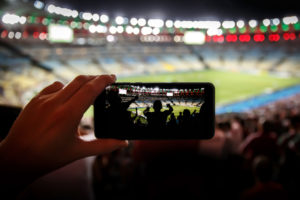 As sports stadiums begin to open to full capacity this fall, plenty of advancements have been made to bring cutting-edge technology to sports venues. There are some noticeable improvements in place now, and more coming soon to a stadium near you.
As sports stadiums begin to open to full capacity this fall, plenty of advancements have been made to bring cutting-edge technology to sports venues. There are some noticeable improvements in place now, and more coming soon to a stadium near you.
5G Ultra-Wideband
Even if you haven’t noticed it yet, 5G has already begun to transform the way we watch and play sports. With unparalleled speeds and ultra-low latency, 5G enables a new kind of network that is designed to enhance the NFL fan experience as well as providing superfast network speeds for retailers, concessions, operations & maintenance, and public safety officials.
Some of the NFL stadiums that are live with 5G ultra-wideband include:
- Bank of America Stadium (Carolina Panthers)
- Empower Field at Mile High (Denver Broncos)
- CenturyLink Field (Seattle Seahawks)
- Ford Field (Detroit Lions)
- Gillette Stadium (New England Patriots)
- Hard Rock Stadium (Miami Dolphins)
- Lucas Oil Stadium (Indianapolis Colts)
- MetLife Stadium (New York Giants and New York Jets)
- M&T Bank Stadium (Baltimore Ravens)
- NRG Stadium (Houston Texans)
- Soldier Field (Chicago Bears)
- U.S. Bank Stadium (Minnesota Vikings)
Cash-Free Experience
Standing in line may be the least favorite activity for fans. Whether it’s purchasing a ticket or a hot dog and a beer, fans go to games to watch, not wait. Tropicana Field, home of the Tampa Bay Rays and the Banc of California Stadium, home of the Los Angeles FC, have embraced a cashless process offering pre-ordered concessions and contactless payment options. Though this trend was coming, the pandemic has many teams looking to implement it faster. Look for this to be the norm for the NFL and other sports in the very near future.
Virtual Reality and AI
In this semi-post-COVID world, teams are looking for ways that fans at home can get the live-action experience from the couch. The Minnesota Vikings are already experimenting with VR broadcasts allowing fans to watch the game from different camera angles, such as on-field view and even VIP suites using a VR headset. Though these devices can cost as much as $1,000 or more now, the technology continues to develop and less expensive options will be available down the road.


